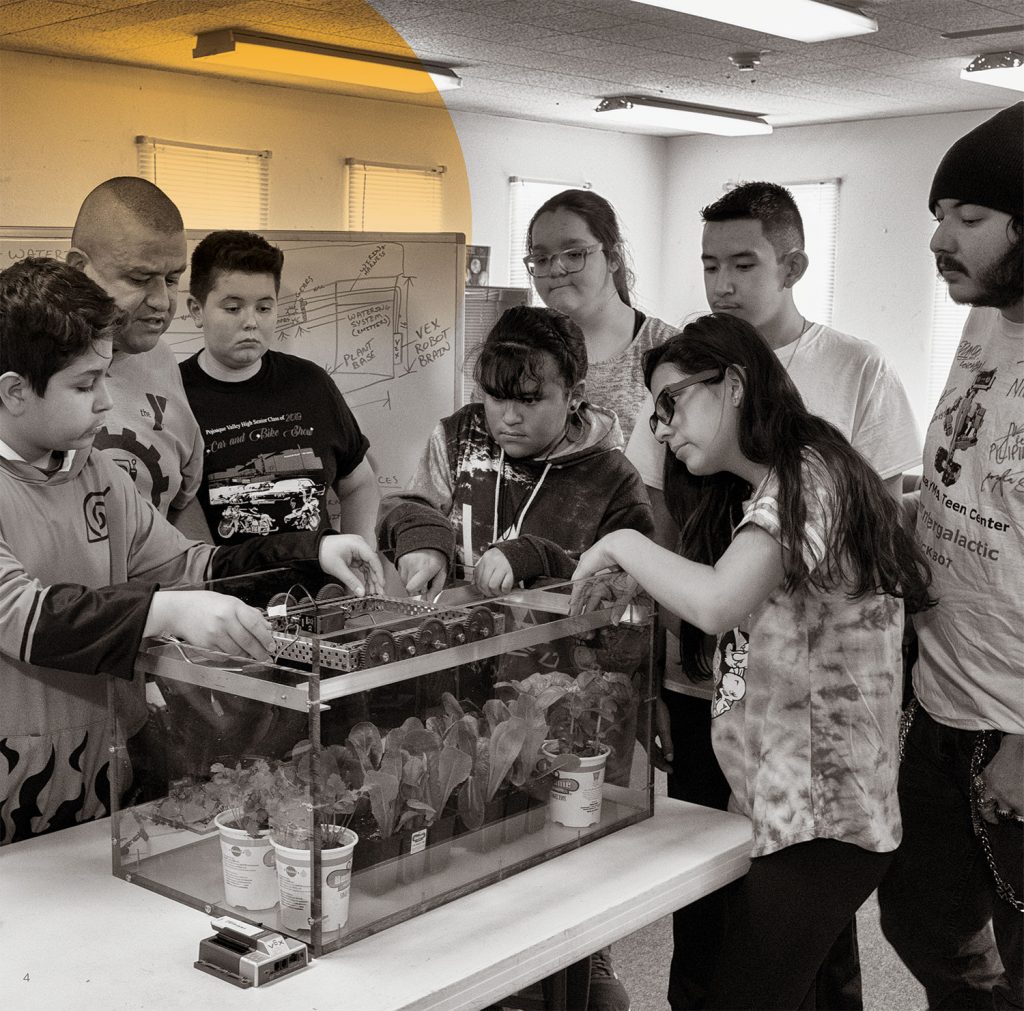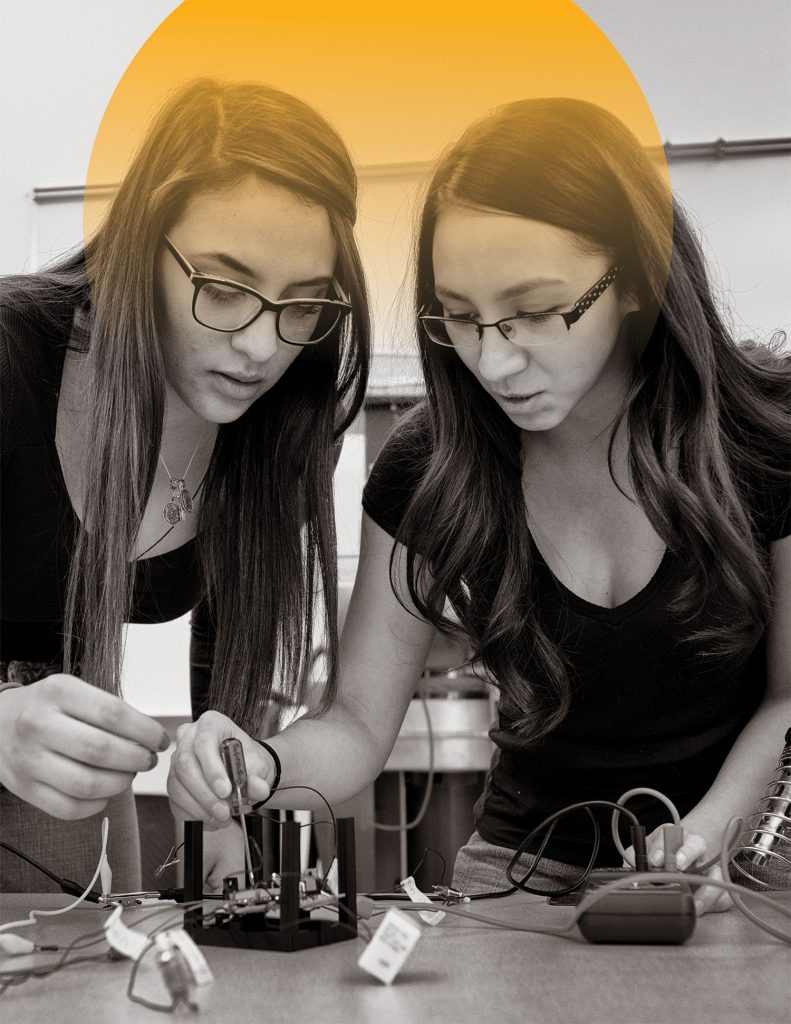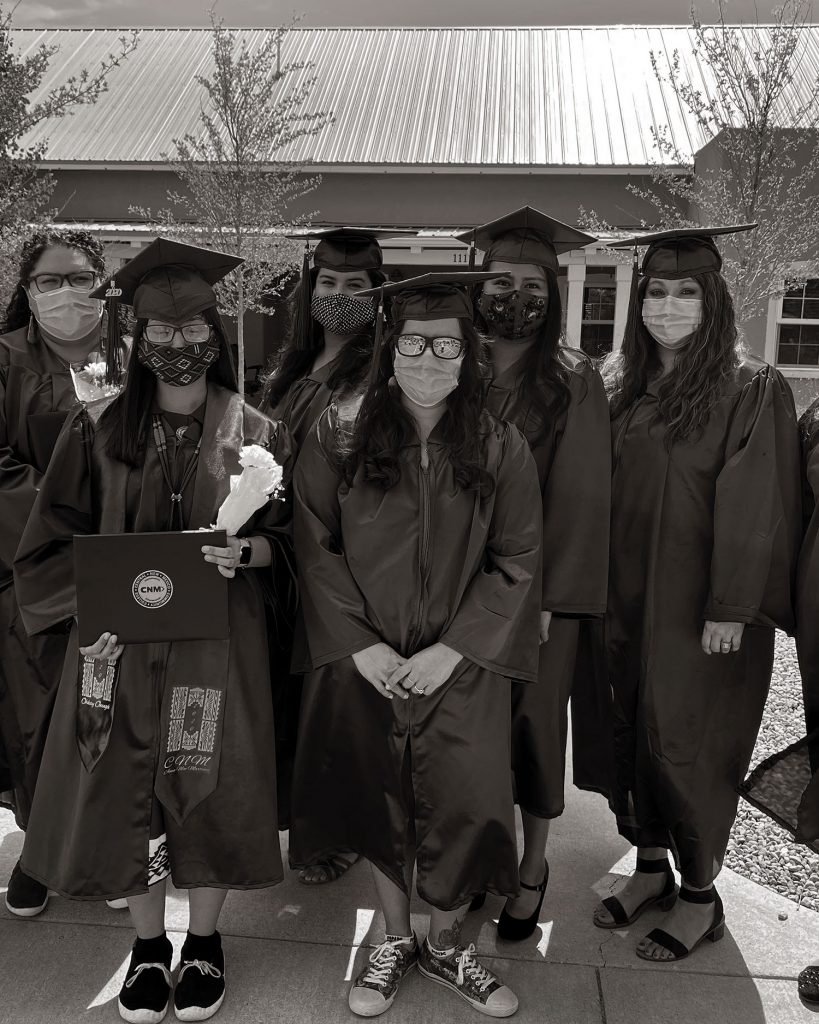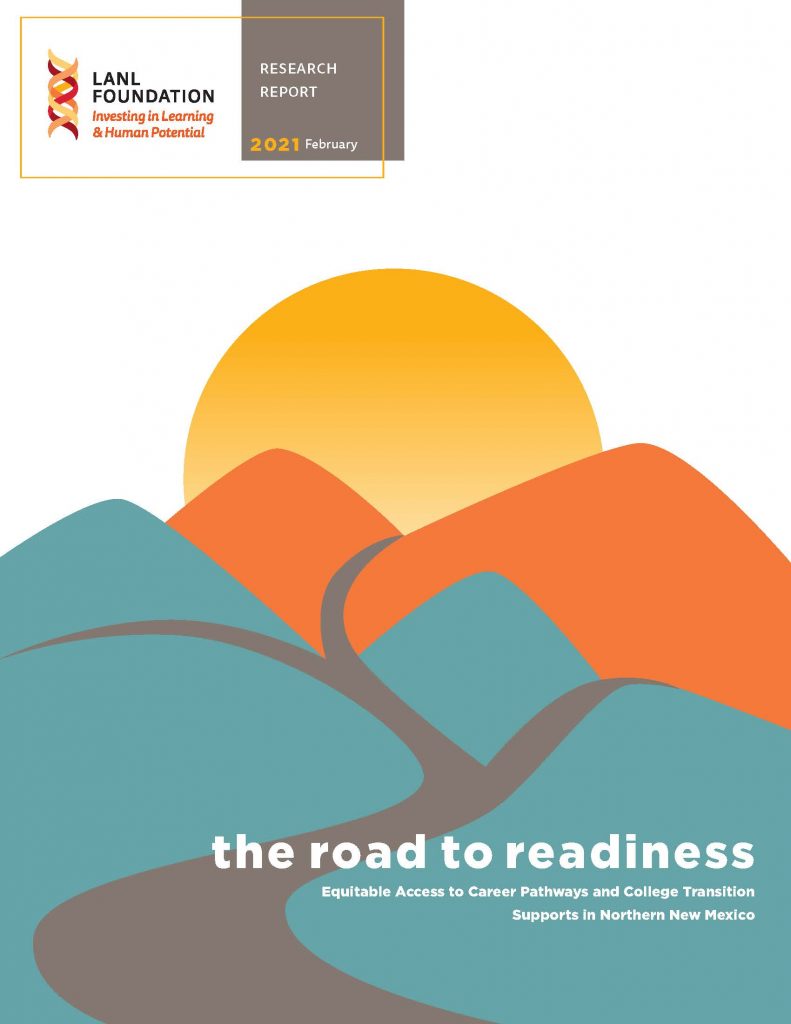Written by Meriah Heredia-Griego, Ph.D. for LANL Foundation Research by Channell Segura, Ph.D., Mike Ammerman, Meriah Heredia-Griego, Ph.D., and Alvin Warren
February 2021
acknowledgements
This research was made possible with generous support from the Los Alamos National Laboratory and Triad National Security, LLC. We are grateful to them for their generous support. The ideas voiced here are those of the author and not of our funders. Most important, thank you to the educators throughout Northern New Mexico who shared their voices and perspectives by participating in this research.
introduction
Northern New Mexico’s youth are our future. It is more important than ever to ensure students have the opportunities they need to becollege and career ready as they complete secondary schooling. The National Skills Coalition projects that 80% of all job openings between 2014 and 2024 in the United States will be middle- and high-skill jobs requiring a workforce certification, college certificate,or degree. It is urgent for New Mexico to prepare students for the 21st century’s knowledge-based economy through a systematic response to the need for robust college and career preparation programs. This policy brief summarizes findings of a study the Los Alamos National Laboratory Foundation conducted in 2019 and 2020 to understand college and career supports and career pathways in Northern New Mexico. It also recommends short-term and long-term opportunities to expand college and career services in our region and other parts ofNew Mexico.
The LANL Foundation worked with education researchers over the course of a year to understand student access to college and career supports and career pathways in the seven-county region served by LANL Foundation: LosAlamos, Mora, Rio Arriba, San Miguel, Sandoval, Santa Fe, and Taos. Administrators from 25 high schools participated in interviews in thefall of 2019. The LANL Foundation contracted a new researcher in fall 2020 to conduct follow-up interviews to understand the immediate impact of the COVID-19 pandemic on college and career supports. Nine schools participated in the follow-up inquiry focused on changes in context and needs for college and career supports and career pathways. Our study intentionally included different types of schools (e.g., charter, tribal, public), different sizes, and rural and urban schools. The results present bright spots and challenges as described by Northern New Mexico school leaders in their efforts to prepare students for college and career in the 21st century.


findings
Our analysis of the insights and experience shared by school administrators elevated five essential elements of the schools’ college and career support systems: course and program availability; college and career resources; access to counselors; college and career supports in remote learning environments, and partnerships for success.
Course and Program Availability
Our study found that students need access to additional academic preparation for college and career. Without some of the prerequisite math and reading skills, students experience barriers to accessing advanced courses such as honors, pre-AP, and AP and placement into college-level dual credit courses that contribute to a postsecondary certificate or degree. While New Mexico high school graduation requirements include taking at least one honors, Advanced Placement (AP), dual credit or distance learning course, 40% of participant schools do not offer honors, pre-AP, or AP classes, and more than 52% do not offer one or more career pathway option for students. The percentage of students who take AP classes in the schools that offer such classes, and the percentage who pass the AP test with a qualification to receive college credit, are both well below the national average. Nearly all of the schools involved in our study had students participating in dual credit. While we found a very high dual credit participation rate, there was concern from school leaders that the course options were not aligned to a career pathway and ultimately not contributing toward a credential or degree.
College and Career Resources
College and career resources in Northern New Mexico schools, such as CTE courses and career pathways programs, were largely dependent on limited and inconsistent external funding. Nine of the 25 schools interviewed received 26 supplemental grants from various sources in 2019, while the remaining 16 schools did not receive supplemental support for college and career programming. GEAR UP or Gaining Early Awareness and Readiness of Undergraduate Programs, a discretionary federal grant program that provides schools with grants for up to seven years to increase the number of low-income students that obtain a secondary school diploma and who are prepared to succeed in postsecondary education, is intended to create systemic change beyond the grant period. Yet, as GEAR UP grants ended in schools, many schools were unable to sustain the supports. Despite the need, most schools in our study reported that they did not apply for, or applied for and did not receive Perkins V or Next Gen grants for the 2020 school year. The Next Gen CTE Pilot does not allow tribally controlled schools to apply for, or receive, Next Gen CTE funding. Furthermore, Federal Bureau of Indian Education (BIE) schools currently do not receive Perkins V funding that flows through the state of New Mexico even though the federal act requires the state to treat such schools as if they were a local educational agency for the purpose of receiving such funding. Instead, tribal secondary and postsecondary schools must com- pete for a very limited pool of national Perkins V funding awarded to only a few dozen tribal grantees annually.

Some schools stated that the low funding amounts and high reporting compliance for the Perkins V grants were burdensome, particularly for smaller and rural schools, and schools described the funding as “too limiting.”
Access to Counselors for College & Career Support
Our study found that limited access to counselors—and almost no access to college and career counselors—impacts the availability of strong individual- ized support for college and career preparation. Counselors are key personnel for connecting students with college and career programming, working with students to develop true Next Step Plans (or a similar success plan for tribal and BIE-funded schools), advising students on course selection and enrollment, assisting students with preparation and registration for entrance and place- ment exams (e.g., SAT, ACT, WorkKeys, Accuplacer, etc.), assisting parents and guardians with FAFSA completion and communicating scholarship deadlines, internship opportunities, and other college and career support opportunities. Of the 25 schools that participated in this project, 52% had one, a part-time or no counselors available for their students. The average counselor to student ratio in our study was 1:195 with the most extreme scenarios being a part-time counselor for every 322 students. As a result, our study found that a quarter of the schools reported that less than 50% of the graduating students completed the FAFSA in 2019. School administrators also indicated that valuable tools like Next Step Plans have become a compliance document rather than a tool that truly supports youth in planning for college and career.
Access to College & Career Programming in a Remote Learning Environment
Our study found that, particularly since the onset of the COVID-19 pandemic, access to broadband and internet has become critical for students to have access to meaningful college and career supports. Unfortunately, sufficient and accessible broadband does not exist in many Northern New Mexico communities.
Free public Wi-Fi and hotspots were not an effective solution for communities without broadband. In communities where there was adequate broadband, individual internet services and rate plans were cost-prohibitive for most families. CTE coursework has been impacted by the limitations of the broadband capacity that do not allow for reliable video streaming. CTE courses that required a lab component to provide interactive, hands-on and work-based learning experi- ences were not offered in fall 2020. Schools are hopeful that the lab courses will be available to students in fall 2021. Where sufficient internet access existed, some students experienced easier access to dual credit courses as higher education institutions made a similar pivot to online learning and virtual college visits and tours.
Partnerships for Success
Schools highlighted the need for more formal relationships with businesses in the form of a memoradum of understanding and for a less restrictive CTE licensure process that can facilitate deeper relationships with business partners through course instruction. While most study participants expressed a need to have more intentional and long-term industry partners, it is unclear how most schools, particularly in rural and remote areas, would have the capacity to cul- tivate, develop, and nurture robust industry partnerships. Some schools have removed CTE courses and career pathways due to the lack of industry partners, CTE teachers, or perceived interest from students. There was little evidence of school-industry partnerships beyond personal relationships with local busi- ness and community volunteers. The COVID-19 pandemic has further reduced already limited work-based learning opportunities in Northern New Mexico.
Our study found that limited access to counselors—and almost no access to college and career counselors—impacts the availability of strong individualized support for college and career preparation.

recommendations
1 | Strengthen College and Career Readiness Programming
It is clear from the findings that—more than honors and AP—dual credit is the vehicle of choice in Northern New Mexico to prepare students for college and career. Additionally, students need access to counselors, CTE teachers and courses, and integrated individual supports.
Recommendations:
- Provide professional development to all high school administration, counselors, and teachers to establish a deeper understanding of how to integrate critical components of college and career preparation across the curriculum.
- Create a continuum of comprehensive personal supports by cross-training high school counselors and college academic advisors to facilitate successful high school to college transitions and attainment.
- Allow districts and BIE-funded high schools to establish a plan for small group rotations of in-person instruction at high school sites that allow students to meet work-based learning curriculum objectives, while still adhering to public health directives that minimize the spread of COVID-19.
- Systematically increase all students’ access to dual credit courses through increasing the number of teachers certified to deliver courses on high school campuses, supporting better collaboration among secondary and postsecondary schools and expanding use of effective remote learning platforms.
- Ensure that all students have comprehensive and personalized support for planning and transitioning to college and careers by providing each high school with a complete system of staff roles supported by the necessary funding and training.
- Incentivize schools to create innovative blends of honors, AP, dual credit and CTE courses to build out the course sequences that currently do not exist.
2 | Enhance Support for Small, Rural and Tribal Schools
The state’s seven-year Next Gen CTE Pilot initiative has the potential to make leaps toward fully integrating CTE into the secondary experience across the state.
Recommendations:
- Ensure tribally controlled and BIE schools have equitable access to essential and adequate funding for similar pathway components, including amending the Next Gen CTE statute and collaborating with tribal nations and BIE-funded schools on Perkins V.
- Complete an analysis of the CTE Pilot to understand the reach and impact on small, rural (as defined by the NM PED), and tribally controlled schools.
- Use the analysis to inform and design an intentional rural and tribal career pathways initiative, possibly patterned off of the New Mexico High School Redesign Network (HSRN) initiative where schools would receive coordinated state, federal, and philanthropic funding, technical assistance, and other support to implement career academies and multiple pathways approaches.
According to Broadband Now, the state of New Mexico ranks 49th in broadband access. Broadband coverage in the seven counties that are part of this study range from 59.4% in San Miguel County to 99.5% in Los Alamos County, with the majority of counties having below 70% coverage.
3 | Secure Recurring, Equitable and Sufficient Funding
In the Martinez and Yazzie Consolidated education lawsuit, the court found that New Mexico was not meeting its constitutional obligation to provide sufficient education to various at-risk students, in part related to school funding levels and financing methods. To fully remedy the failings identified by the court, the state of New Mexico must institutionalize equitable and sufficient funding for college and career programming and supports.
Recommendations:
- Convene the task force requested in House Joint Memorial 2 (2020 Regular Session) introduced by Representative Sheryl Williams Stapleton and Senator Gay Kernan to “examine the funding requirements of developing career technical education programs statewide” due to New Mexico’s limited and inequitable funding for CTE.
- Make adaptations and allow spending flexibility for providing college and career support courses and programs during a global pandemic.
- Amend statute and appropriate sufficient funding to support schools and districts, particularly tribal and rural, to move from inconsistent grant funding to recurring, equitable, and sufficient funding for all college and career supports.
- Co-develop sustainability plans with all schools and districts (rural, tribal, and urban) to strengthen the continuum of college and career programming, pathways, and supports.
- Provide funding for each school to implement a college and career support plan that includes shared equipment and shared hands-on learning facilities, possibly in partnership with local postsecondary institutions and local businesses.

4 | Increase Broadband Access
While several efforts are already underway, the state could consider additional actions with a goal of ensuring 100% residential broadband internet access for all.
Recommendations:
- Establish a state-tribal workgroup to develop a New Mexico Digital Inclusion Plan that would recommend how resources and efforts could be maximized and coordinated to ensure equitable digital access supporting educational engagement across the continuum.
- Create a “unified policy” and designate a single entity to be in charge of coordinating the State’s Broadband Policy, as recommended by the New Mexico Legislative Finance Committee in 2019.
- Launch a new outreach and coordination campaign patterned after NM Counts 2020, to coordinate and focus public, private and philanthropic efforts to best serve “hard to connect” communities.
- Create and fund a low-income discount, subsidy, or voucher program to reduce the cost to low-income households to access broadband services, particularly in rural and tribal areas.

5 | Maximize Business and Education Partnerships
Our study found that partnerships with higher education institutions, industry, and local employers are an essential part of comprehensive college and career supports. The Legislature and Administration can take intentional steps to build partnerships and strengthen collaborations that support college and career preparation.
Recommendations:
- Incentivize secondary and postsecondary schools to pool and collaborate in Perkins V and Next Gen CTE Pilot funding to expand career pathway course sequences that result in a credential or degree.
- Create toolkits and share model practices for convening partners and es- tablishing long-term relationships (including formal contractual agreements) between schools, local employers, and communities. Every study participant understood that the key to any work-based learning experience is hinged on partnerships with local employers.
- Examine tax and other incentives that would lower barriers to entry for smaller and rural employers to partner with schools in providing work-based learning opportunities.
- Expand and scale Future Focused Education’s X3 internship to meet the college and career preparation needs of all students, ensuring adaptation to address barriers in rural areas.
One bright spot is Future Focused Education (FFE), an organization based in Albuquerque that has developed the X3 Internship Program to provide work-based experiences to underrepresented students. Through the pandemic, FFE worked with local employers to strengthen and expand paid internships through virtual internships. The paid internships are credited with keeping kids in school and engaged during COVID-19. This year, FFE began working with two school districts in the sevencounty study region.
Conclusion
While the challenges of protecting the health of children and the education workforce have been daunting for schools during 2020, most have risen to the occasion, working hard to transform the way teaching and learning happens. As one administrator participant phrased it, “learning can happen at any time and anywhere.” Our school system is presented with the opportunity to identify the transformations necessary to increase equity and place student and community needs at the center of solutions. As our state heals from the loss of human life and the economic impact of the COVID-19 global pandemic, it is more urgent than ever that New Mexico lean into systematic changes and innovations in educational practice and policy. Our children are learning during these unprecedented times. Our schools are eager and ready to leverage flexible resources to build upon the existing college and career supports to expand students’ pathways for college, career, and civic participation. A broad collective effort will be essential to address course and program availability, create access to resources, and improve and expand partnerships that prepare our students for life beyond high school.


